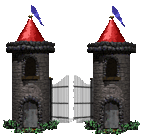





Although these three principal color groups are not usually mixed, a dragon's coloring is rarely uniform. In general, it's scales are composed several color shades from one of the main color categories, with a metallic luster which is hard to define. When the scales have a pale appearance, it is a sure sign of ill health. Many dragons are known by their scales, such as Ancalagon the Black, Smaug the Golden and Spars the Green.
This information has been collect from various resources, and I do not take any credit for it's originality.
